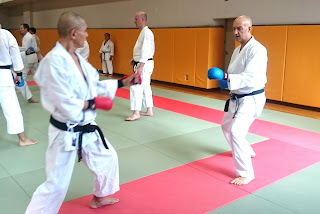From left to right, top row then bottom row:- Sensei Scott Langley, Sensei Alan Higgins, Sensei Richard Malone, Sensei Andy Bailey, Sensei Otto Bakker, Sensei Alex Best, Sensei Simon Bligh, Torunn Fredriksen, Sensei Karin Williams, Sensei Annette Rochford, Angele Jobse.
Well after a few days of relaxation, the hard work began. We traveled via train back to Tokyo, again staying in a Ryokan. Site seeing during the day and training on an evening. Tokyo's underground rail is like a city below a city and without the leadership of Scott Sensei we would have quite easily been lost for hours. On one occasion I got separated, from the group, but thank god for mobile phones.
We trained at Keio Universtity, which has major historical significance in the karate world as being one of the first places that Master Gichin Funakoshi, the founder of Shotokan Karate, started teaching on main land Japan when he left from Okinawa. We were welcomed with open arms by Ota Sensei, who instructed the students at the university and who was our main contact whilst in Tokyo. Ota Sensei not only led some of our training but introduced us to many other instructors including Takakuwa Sensei (All-Japan Masters Kumite Champion three years running) and Yokose Sensei (current All-Japan Masters Kata Champion), plus we had a memorable tour to the Japan Karate Federation Headquarters, who were leading the campaign for karate to be included in the next Olympics. Before we knew it our 5 days in Tokyo was over and our next leg in Okinawa began. Okinawa was a complete contrast to the hustle ad bustle of modern Tokyo. Although most of the old buildings had been destroyed during the Second World War, the feel of the place was much more relaxed. Naha, where we stayed has a commercial touristy feel, similar to Blackpool and a little bit cheesy (In a good way). The restaurant we visited we second to none and we experienced many different ways of cooking including Teppanyaki, where the food was cooked in front of you on giant hot plates by very skilled chefs, who not only cooked the food, but entertained you with their juggling skills, plus Shabu Shabu where we boiled the meats in different broths before eating, Takiniki where we barbecued marinated meats on a grill in the middle of the table. Kanpai was the Japanese equivalent of Cheers, which we used to toast our fellow karateka and Instructors at these social events. Our training at Okinawa was at Senaha Sensei's private Dojo, which being a carpenter he constructed himself, using reclaimed would and other material. He was very much an environmentalist in many ways, re-sing and adapting thrown away items into useful tools in the dojo, such as old pans that he filled with concrete then put a stick in the centre to make traditional chishi (single ended stone lever weight), reclaimed wood to make makiwara (striking posts) and his dojo floor. Senaha Sensei was a Goju Ryu 9th Dan Karate Master and instructed us in his traditional teaching methods, which were very different to those of main land Japan. We spent two days learning breathing methods, Goju Ryu fighting drills and Kata (Self defence techniques put into a set series of movements). The training was over too soon, but we celebrated with a few cups of Senaha's Sensei's special home made rice wine (Which would have blown my socks of if we were wearing them), and a Makiwara competition. Seeing who could strike the wooden post the hardest. The training was now over and we spent the evening in relaxation, heading to the beach for a few hours then over to the famous Dojo Bar for one last fairwell drink. We left Okinawa the next day and after delays, 36 hours later I returned home, battered, exhausted, but buzzing. I cannot express enough my appreciation to our hosts in both Japan and Okinawa for their welcome and inviting us into their dojo's.
Our Karate Itinerary was as follows.
21/10 - Ota Sensei at Keio University Dojo on the first day in Tokyo doing punching drills.

22/10 - Tszuki Sensei the Goju Ryu master with the breathing during bowing and using breathing to help with strength and stability.

Then on the evening with the Old Boysfrom Keio University for Kata where we went through numerous Kata including Goju shiho Gei which was led by Toyota Sensei followed by the picnic in the dojo. Keio University was the first dojo Funakoshi Sensei set up on mainland Japan. Iwamoto Sensei, the gentlemen wearing a red belt, started karate with Funakoshi Sensei and is 88yrs old.


23/10 - We had the tour to the JKF headquarters by Nagura Sensei, General Secretary of the WKF.




Then we trained at Keio University again with Ota Sensei and his young assistant doing kicking drills.

Then on 24/10 we trained with Shibata Sensei at the sports centre doing the kumite drills.


Followed in the evening with the veterans masters doing kumite and kata with Takakuwa Sensei (All-Japan Masters Kumite Champion three years running) and Yokose Sensei (current All-Japan Masters Kata Champion), Nagura Sensei.

Then on to Naha in Okinawa for two days with Senaha Sensei, a Goju Ryu 9th Dan Master.










































No comments:
Post a Comment